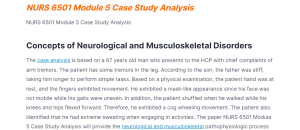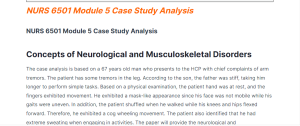NURS 6501 Module 5 Case Study Analysis Concepts of Neurological and Musculoskeletal Disorders
The case analysis is based on a 67 years old man who presents to the HCP with chief complaints of arm tremors. The patient has some tremors in the leg. According to the son, the father was stiff, taking him longer to perform simple tasks. Based on a physical examination, the patient hand was at rest, and the fingers exhibited movement. He exhibited a mask-like appearance since his face was not mobile while his gaits were uneven. In addition, the patient shuffled when he walked while his knees and hips flexed forward. Therefore, he exhibited a cog wheeling movement. The patient also identified that he had extreme sweating when engaging in activities. The paper NURS 6501 Module 5 Case Study Analysis will provide the neurological and musculoskeletal pathophysiologic process based on the patient’s symptoms.
Neurological and Musculoskeletal Pathophysiology Processes
The patient is diagnosed with Parkinson’s disease. Parkinson’s disease affects movement; thus, a

NURS 6501 Module 5 Case Study Analysis
progressive nervous system disorder (McCance & Huether, 2019). Therefore, Parkinson’s disease is caused by degeneration of the brain, causing the impairment or death of the neurons in the body (McCance & Huether, 2019). This leads to the depletion of dopamine due to the formation of the substantia nigra. Notably, when the neurons are normal, dopamine production takes place. Patients with Parkinson’s disease lack dopamine, which effectively improves the blood flow in the body (Taylor et al., 2020).
Therefore, the patient experienced tremors, stiffness, and difficulties walking due to dopamine insufficiency in the body. This shows that dopamine is effective in achieving smooth muscle movement. In addition, a patient with depleted dopamine is also likely to experience other nonmotor symptoms such as autonomic –neuroendocrine changes (Chung et al., 2018).
Moreover, patients who have Parkinson’s disease lose the nerve endings responsible for producing the norepinephrine. The chemical helps control the main function in the body, such as blood pressure and heart rate, thus a messenger to the sympathetic nervous system (Chung et al., 2018). The patient with Parkson’s has a brain cell that consists of Lewy bodies that impact the movement, mood, or behavior (Chung et al., 2018). Lewy bodies are abnormal clumped proteins that develop in the nerve cells and are located in the substantia nigra of a person’s brain.
Racial/Ethnic Variables
Parkinson’s disease is common to neurodegenerative disease among the elderly. The large insurance database identifies that the most affected ethnicity is the Hispanic, with the highest incidence, followed by the black with the lowest (Hayes, 2019). Based on gender, males experience Parkinson’s disease more than women, while the number of patients diagnosed increases with age (McCance & Huether, 2019). The main reason for the increase in the risk of Parkinson’s among men is due to the toxicant exposure, head trauma, and the X linkage of the genetic risk factors (Hayes, 2019).
Interaction of the Processes
A patient with Parkinson’s disease suffers limited movement. This is due to degeneration of the basal

NURS 6501 Module 5 Case Study Analysis
ganglia, which causes a decline in level of dopamine that is inhibited in acetylcholine (Yaday & Kumar, 2022). However, levels of acetylcholine remain active, leading to imbalance in inhibitory neuronal activity and excitatory (Yaday & Kumar, 2022). Therefore, excess neurons cause the ability to generate the voltage of the rapid membrane, whose response is a very small stimulus.
Conclusion
Parkinson’s disease affects a person’s movement since it is a progressive nervous system disorder. Several factors increase the risk of developing Parkinson’s disease, including age, ethnicity, and gender. Men are most likely to suffer from the disease, which can also be hereditary. The early signs of the disease include tremors and trouble in movement.
Our Advantages
Quality Work
Unlimited Revisions
Affordable Pricing
24/7 Support
Fast Delivery